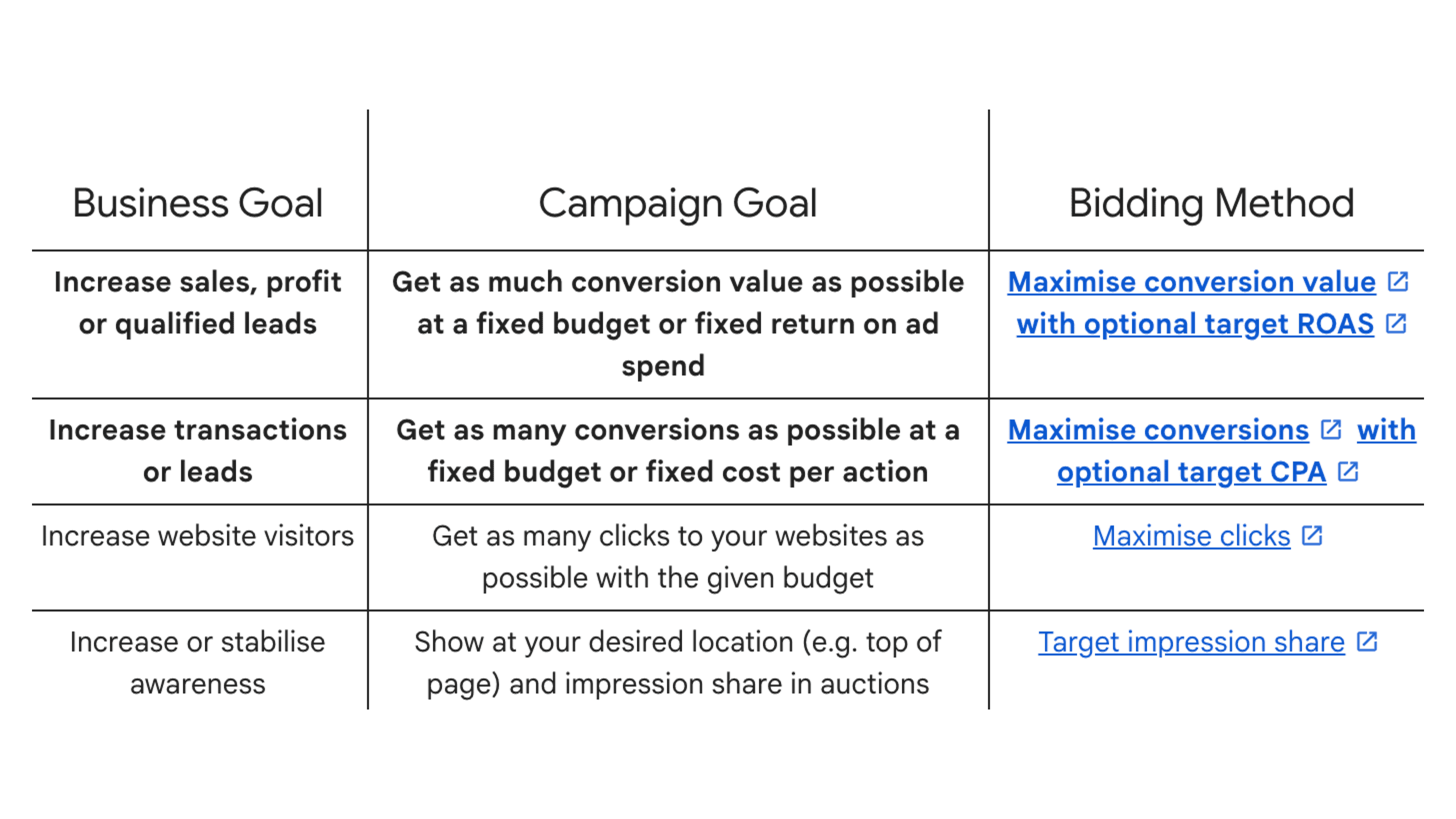Ever felt completely lost when setting up a Google Ads campaign? If so, you’re in good company. Even the most experienced advertisers have had that sinking feeling when they reach the Google Ads bidding section and freeze, wondering: “Should I let Google set my bids automatically, or should I do it myself?”

The reality is, having a good understanding of Google Ads bidding strategies is critical to the success of any campaign. In practice, there are several key factors to pay attention to when deciding which bidding strategy is best for you.
In this post, we’ll work on mastering Google Ads bidding by reviewing how Google Ads bidding works, the differences between automated bidding strategies and manual bidding, and how to work out the best bidding strategy for each campaign in your Google Ads account.
Prefer video? Check out our video The BEST Google Ads Bidding Strategy below:
Still with us? Good, let’s dive in.
What Are Google Ads Bidding Strategies, Really?
Think of your Google Ads bidding strategy as an instruction manual for Google. Essentially, your bidding strategy is how you tell Google to spend your advertising dollars.
So, how does Google Ads bidding work? Here’s a rough idea: Every time someone searches on Google or browses a website in Google’s network, a lightning-fast Google Ads auction happens behind the scenes. Your Google Ads bidding strategy is like your personal representative in that auction, deciding:
- How much you’re willing to pay
- What you’re willing to pay for (a click, a conversion, an impression)
- And how aggressively you want to compete
Choose the wrong Google Ads bidding strategy, and you might as well be throwing money out the window.

Choose the right one, and you’ll see your ROI (return on investment) climb as your bidding strategy aligns perfectly with your goals — whether that’s generating leads, driving sales, or building brand awareness.

Manual vs. Automated Bidding
Before diving into specific bidding strategies, you’ll want to understand the two major approaches to bidding in Google Ads:
Manual Bidding
With manual bidding, you set the maximum amount you’re willing to pay for a click on each keyword or ad group. It’s hands-on, direct, and gives you complete control over your ad spend.
How it works: You decide on a max CPC (cost per click) for each keyword or ad group. For example, if you set a $2.00 max CPC, Google will rarely charge the full amount but will aim to never exceed it during the Google Ads auction process.
Pros of Manual Bidding:
- You decide exactly how much each click is worth to you
- Perfect for tight advertising budgets where every penny of ad spend counts
- Great for learning the ropes and understanding what drives results
- You can prioritize spending on your most valuable keywords (to hopefully maximize your return on ad spend)
- Excellent for brand keywords where you’re already the most relevant advertiser
Cons of Manual Bidding:
- It’s time-consuming, especially with larger campaigns
- You might miss opportunities to maximize conversions that Google’s AI could spot
- You’re limited to optimizing based only on the data you can see and analyze
- Manually making bid adjustments and updating dozens or hundreds of keyword bids can be overwhelming
Manual CPC bidding is like cooking from scratch — more work, but you control every ingredient.

Automated Bidding (Smart Bidding)
With automated (smart) bidding strategies, you hand the keys to Google’s algorithms. You tell Google what outcome matters to you, and Google Ads automatically sets your bids in real-time to try to deliver that outcome.
How it works: First, select a goal (for example, “I want as many conversions as possible at around $20 each”). Then, Google Ads works to calculate an optimal bid for every auction based on the likelihood of achieving your goal with that particular user.
Pros of Automated Bidding:
- Smart bidding allows Google’s AI to make bid adjustments for every single auction
- Automated bidding strategies can save time on bid management
- Google’s AI can process signals advertisers can’t see (such as the user’s device, location, browsing history, etc.)
- Automated bidding strategies often improve performance once Google’s AI has enough data to learn from for each Google Ads campaign
Cons of Automated Bidding:
- Using automated bidding requires you to surrender some control to the algorithm
- Many automated bidding strategies, like maximize conversions, require good conversion tracking to be effective
- Needs sufficient data to “learn” before performing well
- Automated bidding strategies can sometimes spend your advertising budget in unexpected ways
- If you set unrealistic targets for smart bidding to chase, your Google Ads campaign might stall completely
Automated bidding is like using a smart appliance — it requires less hands-on work, but you need to trust the technology to achieve your desired result.
Types of Bidding Strategies: A (Quick) Overview
Beyond the basic manual versus smart bidding distinction lies a more nuanced landscape of Google Ads bidding strategies.
Manual Bidding Strategies
For advertisers who prefer to have direct involvement with their campaigns:
- Manual CPC bidding: puts you in the driver’s seat. You establish maximum CPC (cost per click) thresholds based on your own judgment and market knowledge. Simple but effective when you know your numbers.
- Enhanced CPC: offers a middle ground. While you set the baseline bids, Google adjusts them in real-time based on conversion potential.
Automated Bidding Strategies:
When efficiency and scale become priorities, consider the automated bidding strategies below:
- Maximize Clicks: Using a maximize clicks bidding strategy, Google tries to get you the most clicks possible within your budget. Maximize clicks bidding is especially good for traffic goals.
- Maximize Conversions: Maximize Conversions aims to get you as many conversions as possible within your budget.
- Target CPA: You set a target cost per acquisition (CPA), and Google optimizes to get conversions at that cost.
- Target ROAS: With a target ROAS bidding strategy, You set a target ROAS (return on ad spend), and Google bids higher for likely high-value conversions.
- Maximize Conversion Value: Maximize Conversion Value is like Maximize Conversions, but focused on the total value/revenue, not just the count.
- Target Impression Share: A target impression share strategy is focused on visibility. With target impression share bidding, you specify how often you want your ads to appear.
Which Bidding Strategy is Better for Beginners?

The honest answer: it depends.
If you’re just starting out with a small budget and want to learn the ropes, Manual CPC gives you control and visibility into exactly what’s happening. You’ll learn faster this way, seeing directly how your bid changes affect performance.
If you have a decent budget and good conversion tracking set up, smart bidding can often get you better results faster, especially if you don’t have time to micromanage bids.
Many successful Google Ads advertisers take this approach:
- Start with a Manual CPC bidding strategy to gather initial data and understand their market
- Once they have enough conversions (ideally 15-30 conversions per Google Ads campaign in a month), switch to an automated bidding strategy to scale and optimize
- Continuously test different bidding strategies as their Google Ads campaigns mature
Before selecting any bidding strategy, you’ll want to think through your goal.
What specific action do you want people to take after seeing your ad?
If you want…:
- To increase website traffic and visibility → Consider Maximize Clicks or Target Impression Share
- To get more conversions (sales, sign-ups, or leads) → Look at bidding strategies like Target CPA or Maximize Conversions
- To maximize revenue → Consider a Target ROAS or Maximize Conversion Value bidding strategy
- To improve brand awareness → Utilize a Target Impression Share (for Search) bidding strategy
Your answer to this question should guide your strategy.
Getting Started: Best Practices
No matter which bidding strategy you choose, these foundational best practices will set you up for success:
- Set up accurate conversion tracking: If you plan to use any conversion-based bidding strategy, proper tracking in your Google Ads account is non-negotiable.
- Start with realistic targets: If you’re using a Target CPA or ROAS bidding strategy, begin with numbers that are close to your current performance, not aspirational goals.
- Give the algorithm time to learn: Smart bidding strategies need 1-2 weeks to stabilize — don’t panic about fluctuations during this learning period.
- Monitor key metrics regularly: Keep an eye on costs, conversions, and efficiency metrics to ensure things are moving in the right direction (and that you’ve chosen a bidding strategy that works for your Google Ads account).
- Use negative keywords: Even automated bidding strategies need your help to avoid irrelevant traffic. Add negative keywords regularly.
- Don’t neglect ad quality: A great Google Ads bidding strategy can’t fix poor ads or landing pages. Keep refining your creative and targeting.
Final Thoughts
The perfect bidding strategy isn’t universal — it’s the one that aligns with your specific business objectives and budget. Get that right, and you’re already ahead of most advertisers.



